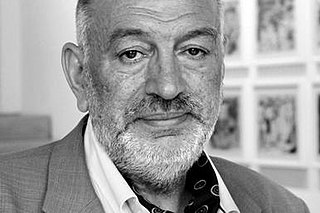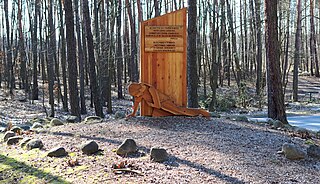
The Romani Holocaust was the planned effort by Nazi Germany and its World War II allies and collaborators to commit ethnic cleansing and eventually genocide against European Roma and Sinti peoples during the Holocaust era.

The Sinti are a subgroup of Romani people. They are found mostly in Germany, France and Italy and Central Europe, numbering some 200,000 people. They were traditionally itinerant, but today only a small percentage of Sinti remain unsettled. In earlier times, they frequently lived on the outskirts of communities.
The Romani people have long been a part of the collective mythology of the West, where they were depicted as outsiders, aliens, and a threat. For centuries they were enslaved in Eastern Europe and hunted in Western Europe: the Pořajmos, Hitler's attempt at genocide, was one violent link in a chain of persecution that encompassed countries generally considered more tolerant of minorities, such as the United Kingdom. Even today, while there is a surge of Romani self-identification and pride, restrictive measures are being debated and passed by democratic states to curb the rights of the Romani people.
A Holocaust memorial day or Holocaust remembrance day is an annual observance to commemorate the victims of the Holocaust, the genocide of six million Jews and of millions of other Holocaust victims by Nazi Germany and its collaborators. Many countries, primarily in Europe, have designated national dates of commemoration. In 2005, the United Nations instituted an international observance, International Holocaust Remembrance Day.

The International Holocaust Remembrance Day, or the International Day in Memory of the Victims of the Holocaust, is an international memorial day on 27 January that commemorates the victims of the Holocaust, which resulted in the genocide of one third of the Jewish people, along with countless members of other minorities by Nazi Germany between 1933 and 1945, an attempt to implement its "final solution" to the Jewish question. 27 January was chosen to commemorate the date when the Auschwitz concentration camp was liberated by the Red Army in 1945.

Anti-Romani sentiment is a form of bigotry which consists of hostility, prejudice, discrimination, racism and xenophobia which is specifically directed at Romani people. Non-Romani itinerant groups in Europe such as the Yenish, Irish and Highland Travellers are frequently given the name "gypsy" and as a result, they are frequently confused with the Romani people. As a result, sentiments which were originally directed at the Romani people are also directed at other traveler groups and they are frequently referred to as "antigypsy" sentiments.

Ceija Stojka was an Austrian Romani writer, painter, activist, and musician, and survivor of the Holocaust.

Romani Rose is a Romany activist and head of the Central Council of German Sinti and Roma. He lost 13 relatives in the Holocaust.
The Central Council of German Sinti and Roma is a German Romani rights group based in Heidelberg, Germany. It is headed by Romani Rose, who lost 13 members of his close family in the Romani Holocaust. The organization is a member of the Federal Union of European Nationalities.
The European Civil Rights Prize of the Sinti and Roma was founded in November 2007 in Heidelberg by the Central Council of German Sinti and Roma, the Documentation and Cultural Centre of German Sinti and Roma and the Manfred Lautenschläger Foundation. The international prize is endowed with 15,000 Euro by the Foundation. It was awarded for the first time in December 2008.
Jakob "Johnny" Bamberger was a Sinti boxer and later an activist in the Romani civil rights movement.

The Memorial to the Sinti and Roma Victims of National Socialism is a memorial in Berlin, Germany. The monument is dedicated to the memory of the 220,000 – 500,000 people murdered in the Porajmos – the Nazi genocide of the European Sinti and Roma peoples. It was designed by Dani Karavan and was officially opened on 24 October 2012 by German Chancellor Angela Merkel in the presence of President Joachim Gauck.

Nicolae Gheorghe was a Romanian human rights activist. He was born in Roșiori de Vede.
Roma Routes was established in 2007 to encourage the study of European heritage and culture. The project was established by the European Union and ended in 2013. The main purpose of Roma Route was to break the "cultural barrier" between the Roma and Non-Roma. Roma is a very lonely group in Europe, and most European countries have "discrimination" against Roma. Discrimination in most European countries also prevents Roma's culture from spreading worldwide. Through Roma Route, the European Union hopes to change the living conditions of the Roma and enhance the cultural communication of the Roma to the world.

The Roma Holocaust Memorial Day is a memorial day that commemorates the victims of the Romani genocide (Porajmos), which resulted in the murder of an estimated 220,000–500,000 Romani people by Nazi Germany and its collaborators during World War II. The date of 2 August was chosen for the memorial because on the night of 2–3 August 1944, 2,897 Roma, mostly women, children and elderly people, were killed in the Gypsy family camp (Zigeunerfamilienlager) at Auschwitz concentration camp. Some countries have chosen to commemorate the genocide on different dates.
Margarete Kraus was a Roma woman who was persecuted during the Porajmos, imprisoned at Auschwitz and Ravensbruck. Her experience was recorded in later life by the photographer Reimar Gilsenbach.
Elisabeth Guttenberger was a German Holocaust survivor and human rights activist. Of Sinti origin, she survived the Romani Holocaust and testified at the Frankfurt Auschwitz trials after having been interned at the Gypsy family camp.
Melanie Spitta was a German Sinti film-maker.
Anita Awosusi is a German writer, musician, documentary filmmaker and human rights activist. Herself a Sinti woman, she has been active in campaigns for the rights of the Sinti and Romani people. Since the 1990s, she has published works on the history of the Romani Holocaust, on the music and on stereotyped representations of Sinti and Roma.
Petra Gelbart is a musicologist, musician, music therapist and human rights defender. Born in former Czechoslovakia, she has lived in the United States since 1988. Mainly active for the human rights of Romani people, she was a curator of the music section for the RomArchive in Berlin, Germany. Active in several Romani organizations since 2000, Gelbart is known both for her research, public speaking and musical performances focusing on the remembrance of the Romani genocide in Europe.










